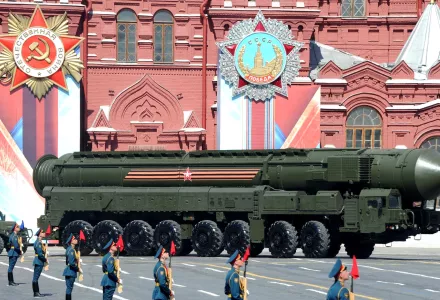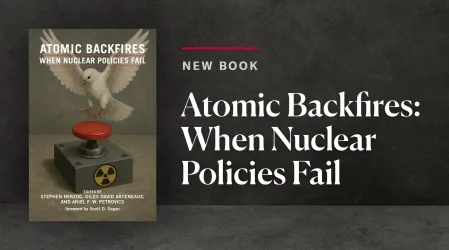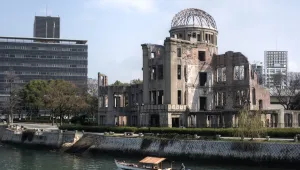
This essay appears in the American Academy of Arts & Sciences report, "Nuclear Perils in a New Era: Bringing Perspective to the Nuclear Choices Facing Russia and the United States," along with an essay by Alexey Arbatov.
The first half century of the nuclear age witnessed the gradual construction of a global nuclear order designed to mitigate nuclear dangers, inhibit arms racing, and prevent the spread of nuclear weapons to additional states. Spurred by the experiences, the dangers, the crises, the near misses, and the frightening risks on display in the early years of the Cold War, sustained efforts were made, in McGeorge Bundy’s vivid phrase, “to cap the volcano.” The time had arrived, Bundy wrote in 1969, for the two great nuclear superpowers “to limit their extravagant contest in strategic weapons,” a contest that had “led the two greatest powers of our generation into an arms race totally unprecedented in size and danger.” In the subsequent twenty-five years after Bundy’s appeal, an increasingly elaborate and institutionalized arms control process produced, with many ups and downs, a detailed web of constraints on the nuclear behavior of the superpowers. The articulated goal was to stabilize the superpower nuclear balance by reinforcing mutual deterrence. The vast nuclear arsenals of the superpowers, however, were not the only source of nuclear danger. In a world in which the number of states armed with nuclear weapons was slowly growing and many additional states had interest in acquiring such weapons or the technology to produce them, there was reason, as Albert Wohlstetter warned in 1961, to be “concerned with the enormous instabilities and dangers of a world with many nuclear powers.” Such a world—“life in a nuclear armed crowd”—Wohlstetter wrote in a later famous study, was widely believed to be “vastly more dangerous than today’s world.” The desire to prevent this unattractive world led to the negotiation of the Nuclear Nonproliferation Treaty (NPT), which entered into force in 1970, and to the subsequent development of an associated regime intended to create legal and technical barriers to the spread of nuclear weapons. Thus, in reaction to the major perceived dangers of the nuclear age, there emerged what Lawrence Freedman calls the “twin pillars” of the global nuclear order: mutual stability in the major nuclear rivalry and nonproliferation to inhibit or prevent the spread of nuclear weapons to additional states.
By the end of the Cold War, mutual deterrence and strategic arms control had been deeply embedded in the relationship between the United States and the Soviet Union, and most states in the international system had, by joining the NPT, undertaken a legally binding pledge not to acquire nuclear weapons. The collapse of the Cold War structure and the end of reflexive hostility between Moscow and Washington seemed to suggest that a much more cooperative international security system might be possible and that a golden age of ambitious arms control might beckon. To be sure, there were still worries about nuclear dangers and still debates about the effectiveness of the NPT system, but in general there was optimism about what President George H. W. Bush labelled “the new world order.” “The winds of change are with us now,” Bush concluded confidently in his moving and triumphant State of the Union Address in January 1991. A safer world, in which nuclear dangers would be contained by cooperative management, seemed to be at hand—or at least possible.
Nearly three decades later, it is evident that such hopes for a benign nuclear order have been dramatically disappointed. Harmony and cooperation among the major powers have not been preserved, a golden age of arms control and disarmament has not arrived, and the nonproliferation norm has not been universally respected. Instead, Russia’s relations with the United States and the West have grown difficult and sometimes toxic. China’s rise has added a significant complication to the nuclear calculations of Washington and Moscow. Several new nuclear-armed states have emerged, creating complicated and unprecedented regional nuclear dynamics, while protracted crises over the nuclear ambitions of Iran and North Korea have called into question the effectiveness of the NPT regime. Important pieces of the arms control framework inherited from the Cold War era have been rejected or jettisoned while others are undermined and jeopardized by contentious compliance disputes—and at present there appears to be little serious interest in reviving the arms control process, either bilaterally or multilaterally. Meanwhile technological advances in surveillance and accuracy have the potential to erode the survivability of deployed nuclear forces and thereby undermine the deterrence stability that has been one of the pillars of the global nuclear order. Compared to the high hopes of 1991, the current state of the global nuclear order is shockingly worrisome: political relations are frayed, stability is jeopardized, and arms control has deteriorated. The potential implications are enormous. As Gregory Koblenz argues in his recent analysis of the evolving nuclear scene, the United States could find itself “trapped in a new nuclear order that is less stable, less predictable, and less susceptible to American influence.”
How did we arrive at this point and what are the forces that are shaping the negative evolution of the global nuclear order? In what follows, I provide broad-brush sketches of three phases of the nuclear age, sketches that demonstrate movement from an unregulated and highly competitive environment to one that gradually becomes highly regulated and collaboratively (sometimes cooperatively) managed. What has come to dominate the story is the striking turn in the narrative arc in recent years toward a less regulated and more contentious third phase in the history of the global nuclear order. Old concerns (such as missile defense) have resurfaced while new problems (such as multilateral deterrence) have arisen. It is not entirely clear yet where we are headed but there should be no doubt that fundamentally important questions should be on the agenda. Are we going to be living in a nuclear world that is more laden with friction, more multilateral, less stable, less constrained by negotiated agreement, and possibly populated with additional nuclear-armed actors? Will some of the undesirable characteristics of the early years of the nuclear age re-emerge? If so, what can be done to address the emerging nuclear dangers? If we are headed into or are already living in a new nuclear age, how can it be managed safely and prudently? A brief examination of the history of the nuclear order provides the context for and demonstrates the significance of these questions.
Miller, Steven E. “The Rise and Decline of Global Nuclear Order?.” American Academy of Arts & Sciences, April 2021
The full text of this publication is available via American Academy of Arts & Sciences.





